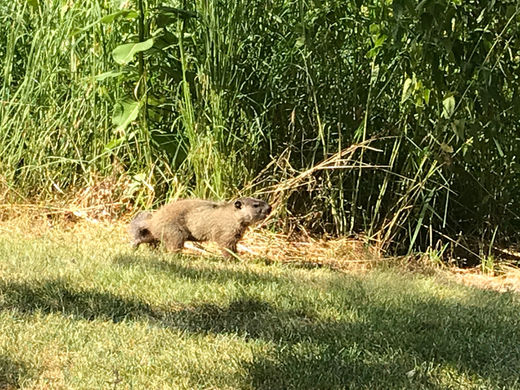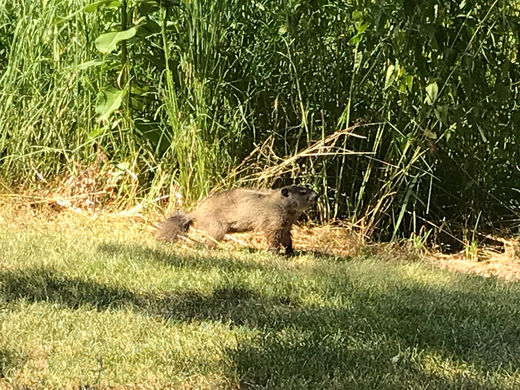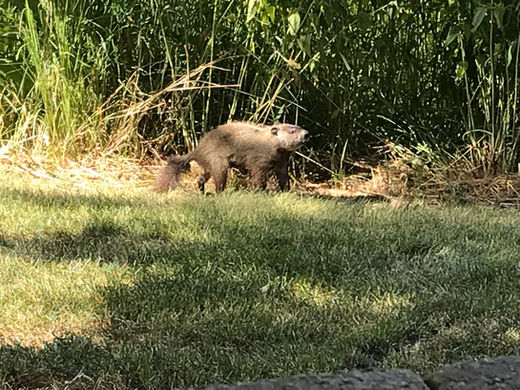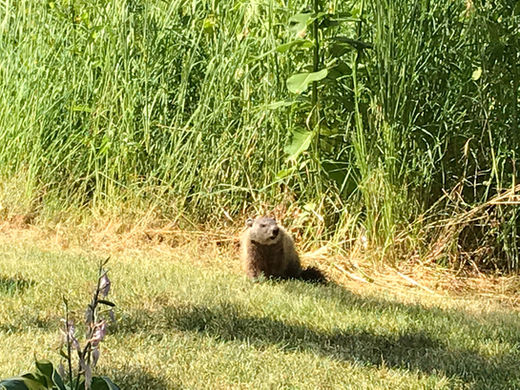Woodchuck
Common Name: Woodchuck (Groundhog).
Scientific Name: Marmota Monax.
What to look for? Look for “Punxsutawney Phil”? Woodchucks, also known as groundhogs, are of a stocky and sturdy build. They are a type of rodent known as a marmot which is closely related to squirrels; so, you might think of looking for a “giant ground squirrel.” The pelage, or fur, of a Woodchuck varies greatly in color from gray to cinnamon to dark brown. Their body is covered with white-tipped guard hairs giving them a grizzled appearance. Their paws are typically black to dark brown. And Woodchucks have a short, bushy, black or dark brown tail that is approximately six inches long. They will often stand up on their hind legs, making them look tall.
Where can they be found at Carillon Stonegate Pond? The Woodchuck is not a very frequent sighting. However, you may find one along the banks of our ponds.
How big are they? The Woodchuck is about two feet in total length. And they may weigh up to thirteen pounds.
How else do they behave? Although Woodchucks are solitary animals, they will sometimes greet each other nose to nose. Dominant males have sizeable home ranges of approximately six square miles, which usually overlaps with those of at least 2 other females. Woodchucks are often found sunning themselves in the middle of the day during summer. Woodchucks avoid predators by climbing trees. Woodchucks are burrowing mammals and generally construct summer and winter dens which may have several entrances (including an escape hole) and many chambers and tunnels.
What’s for dinner? How much wood can a Woodchuck chuck? Turns out none! Woodchucks are omnivorous with the majority of their diet being plant matter. They forage on grasses, ferns, leaves of bushes, alfalfa, soybeans, clover, and dandelion. Other foods include bark, insects, and bird eggs. All Woodchucks store fat for winter hibernation. Woodchucks are diurnal, or active during the day, and may forage for several hours during the morning and afternoon. An adult Woodchuck can eat more than a pound of vegetation daily.
Where do they take up residence? The Woodchuck is the most widespread North American marmot species. They reside across the U.S. from eastern Oklahoma across to North Carolina and north into southern Canada. Woodchucks are typically found in forests, small woodlots, fields, pastures, and hedgerows. They construct dens in well drained soils, and most have summer (located near food sources) and winter (located near protective cover) dens. Woodchucks construct expansive burrows which can be more than 60 feet in length. Most burrows have separate sleeping areas, food storage areas and refuse tunnels.
When and where do they breed and nest? Woodchucks are polygynous, with males having multiple mates per season. Male Woodchucks emerge from hibernation earlier than females in order to establish territories, dominance hierarchies, and to search for mates. With the exception of mating season, Woodchucks are non-social. Breeding occurs shortly after emergence from hibernation in the spring (late February into May). Female woodchucks give birth to approximately five offspring, or pups. Gestation lasts approximately 31 days and weaning occurs around 44 days old. Pups become independent very quickly and leave the mother around age 2 months old.
Where do they migrate? Nowhere! Woodchucks are true hibernators. The Woodchuck will winter in its burrow from about October until around late February. Hibernation is not a deep, continuous sleep for the entire winter. Rather they go through bouts of “torpor” where their body temperature drops to about 40 degrees Fahrenheit and they sleep for about a week; then they wake up for several days; then go back into torpor. This may occur twenty times or more during the hibernation.
Do they make any interesting sounds? Woodchucks are nicknamed “whistle pig” for their shrill whistle. They produce this whistle when threatened and as a warning call to juvenile woodchucks. They may also hiss, growl, shriek, teeth-chatter, and bark.
Interesting Facts About Woodchucks:
-
The name Woodchuck has nothing to do with wood and it may have its roots in the Algonquian or Narragansett name for the animal: "wuchak".
-
They are generally solitary animals.
-
Farmers consider them pests with their underground burrows causing big headaches for those in the agricultural profession as well as their preference for tender, young green crops.
-
They live in underground burrows which can be very elaborate.
-
Wolves, coyotes, foxes, black bears, lynx, bobcats, hawks, some snakes, and domestic dogs are all predators of the Woodchuck.
-
The average life span of the Woodchuck is three years.
-
Due to their abundance and broad geographic range, woodchucks are listed as a species of least concern on the IUCN Red List of Threatened Species.
For more information on Woodchucks and sources of information used in this blog (these are several of the sources that I am using to learn as I blog), please visit National Geographic, University of Michigan Animal Diversity Web, N.H. PBS and Mass Audubon.
The Carillon at Stonegate community is very fortunate to have a variety of wetland, forest and prairie environments conducive to a variety of birds and other wildlife, insects and plants. Our community and the Kane County Forest Preserve do an exceptional job in maintaining this natural environment – both for the benefit of the birds and wildlife and for our residents to enjoy.
Take a hike and see what you can find – and identify!




